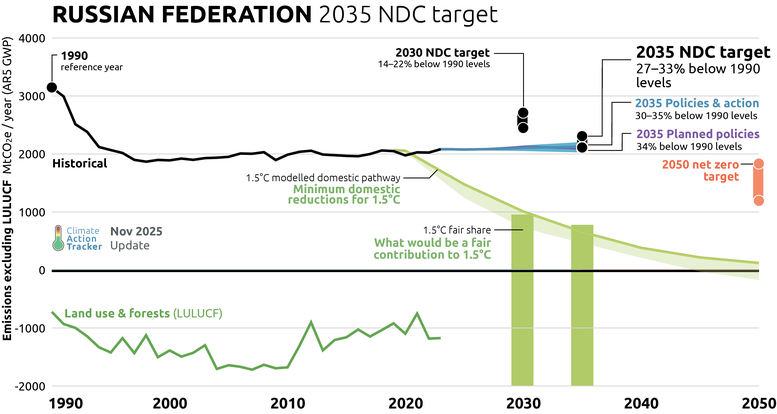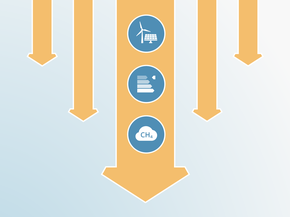2035 NDC
2035 NDC Target Overview
Russia’s 2035 target falls far short of 1.5˚C compatibility, reflecting only a marginal adjustment compared to its 2030 commitments and highlighting the profound indifference of one of the world’s top fossil fuel producers to taking serious climate action. The 2035 NDC did not strengthen the 2030 mitigation target, which it has not updated. Russia can achieve both its 2030 and 2035 NDC targets under current policies, leaving little incentive for deeper emissions reductions or going beyond business-as-usual. With this new target, the already substantial gap between Russia’s current trajectory and a 1.5˚C compatible pathway increases further, nearly doubling from 429 MtCO2e in 2030 to 799 MtCO2e in 2035.
Excluding LULUCF, Russia's 2035 target corresponds to emissions 27–33% below 1990 levels, or 2,113–2,308 MtCO2e. To be 1.5˚C compatible compared to modelled domestic pathways, Russia would need to reduce its emissions by 79% below 1990 levels by 2035, or to 657 MtCO2e excluding LULUCF. As a developed country and major global emitter, Russia should significantly improve its climate ambition by strengthening its 2030 and 2035 NDC targets and adopting a plan for phasing out the production, export, and use of fossil fuels.
The inclusion of the land and forestry (LULUCF) sector and Russia’s flexibility in recalculating its historical emissions inventory weaken the 2035 target's transparency and reduce its comparability. The latest inventory updates have sharply increased the size of the estimated forest sink, easing the pressure to make real emissions reductions in other areas of the economy. Relying on LULUCF to meet emissions targets is dangerous because the global sink is weakening; without investment in renewable energy and technologies that drive real emissions reductions, Russia will be left without the tools needed to meet its climate commitments.
Meanwhile, the Energy Strategy 2050 locks in fossil fuel dependence, maintaining high levels of oil and fossil gas production and expanding coal output while allowing only marginal growth in renewables, with the majority coming from new hydroelectric power. Given the scale of Russia’s fossil fuel exports, increases in domestic production can have a serious, negative impact on global emissions. These factors further undermine the credibility of Russia’s climate targets and highlight the continued absence of a shift towards decarbonisation by one of the world’s largest fossil fuel producing states.
Russia currently makes no substantial contribution to climate finance in developing countries. To demonstrate international leadership and align with global climate goals, Russia should increase support for emissions reductions in low-income countries.
| RUSSIAN FEDERATION | 2035 NDC Target | |
|---|---|---|
| 2030 target | ||
|---|---|---|
| Formulation of target in NDC | Has not updated the ambition of its 2030 target, please see the full 2030 NDC assessment in the Targets tab | |
| Status | Submitted on 25 November 2020 | |
| 2035 target | ||
|---|---|---|
| Formulation of target in NDC | Limiting GHG emissions to 65–67% compared to the 1990 levels by 2035, taking into account the maximum possible absorptive capacity of forests and other ecosystems and subject to sustainable and balanced socio-economic development of the Russian Federation and its non-discriminatory access to equipment and technologies, necessary to reduce (mitigate) greenhouse gas emissions and/or increase its removals. | |
| Absolute emissions level in 2035 excl. LULUCF |
Level of emissions to be achieved in total through domestic action and use of international market credits (full NDC target)1 Up to 2,113–2,308 MtCO2e (27–33% below 1990) (6–16% above 2010) |
|
| Status | Submitted on 29 September 2025 | |
1 Russia’s 2035 NDC contains no reference to international market mechanisms, indicating that the target is intended to be achieved entirely through domestic action.
Ambition
For the world to have a significant chance of limiting warming to 1.5˚C, governments must switch to emergency mode and strengthen both their 2030 targets and current policies to include substantial emissions cuts and significantly contribute to closing the 2030 emissions gap. Russia’s 2035 NDC submission did not increase the ambition of its 2030 target.
Further information on Russia’s 2030 target can be found here.
2030 NDC Target
| 2030 target | ||
|---|---|---|
| Is the target, international climate finance, and other forms of support 1.5°C compatible compared to fair share? |
|
|
|
Is the target 1.5°C compatible compared to modelled domestic pathways? |
|
|
|
Is this a stronger target than previously submitted? |
|
|
2035 NDC Target
| 2035 target | ||
|---|---|---|
| Is the target, international climate finance, and other forms of support 1.5°C compatible compared to fair share? |
|
|
|
Is the target 1.5°C compatible compared to modelled domestic pathways? |
|
|
|
Does the NDC include sectoral targets? |
|
|
|
Does the NDC include a renewable energy capacity target? |
|
|
|
Does the target align with the country’s net-zero pathway? |
|
|
Russia submitted its 2035 NDC mitigation target on 29 September 2025, setting a target of limiting GHG emissions to 65–67% of 1990 levels by 2035. The target covers all sectors and all gases. The CAT excludes emissions from land use, land use change and forestry (LULUCF) from this target, resulting in an emissions level of 2,113–2,308 MtCO2e in 2035, or a 27–33% reduction below 1990 levels.
Russia’s 2035 NDC target is not 1.5˚C compatible compared to modelled domestic pathways because it is far above the 1.5°C compatible threshold of 657 MtCO2e, excluding LULUCF. To be 1.5˚C compatible, Russia would need to reduce its emissions by 79% below 1990 (excl. LULUCF). To contribute to its fair share of climate action, Russia would need to further reduce its domestic emissions and support emission cuts abroad.
Russia did not strengthen its 2030 NDC target when submitting its 2035 NDC, leaving the earlier, already unambitious goal unchanged. The 2035 target reflects only a marginal adjustment compared to its previous commitments and does not represent a meaningful increase in ambition. Although Russia frames its 2035 NDC as being consistent with its long-term goal of carbon neutrality by 2060, the target is not supported by a defined pathway aligned with a net zero trajectory. Both the 2030 and 2035 targets can be met under existing policies, indicating no additional effort to accelerate emission reductions. With a new target, the already substantial gap to a 1.5˚C compatible pathway remains significant, ranging from 1,439–1,702 MtCO2e in 2030 to 1,456–1,651 MtCO2e in 2035.
Russia’s sectoral plans and targets remain far from alignment with the Global Stocktake (GST) and goals such as tripling renewable energy capacity, phasing out inefficient fossil fuel subsidies, and ending deforestation by 2030. The Energy Strategy 2050 foresees only a limited expansion of renewable capacity, with the majority coming from new hydroelectric power plants. This leaves solar and wind at a mere 1% share of total installed capacity and electricity generation by 2050.
Further information on Russia’s targets can be found here.
| RUSSIAN FEDERATION | Target summary (excluding LULUCF) |
|---|
| 2030 target: Emissions reductions from 1990 levels (CAT estimates) | ||
|---|---|---|
| Current policies in 2030 | 32–34% | |
| 2030 NDC target | 14–22% | |
| 1.5°C fair share |
70% (To be reached by providing international climate finance and other forms of support that facilitate substantial emissions reductions internationally) |
|
| 1.5°C modelled domestic pathway | 68% | |
| 2035 target: Emissions reductions from 1990 levels (CAT estimates) | ||
|---|---|---|
| Current policies in 2035 | 30–35% | |
| 2035 NDC target | 27–33% | |
| 1.5°C fair share |
75% (To be reached by providing international climate finance and other forms of support that facilitate substantial emissions reductions internationally) |
|
| 1.5°C modelled domestic pathway | 79% | |
Fairness & Finance
Developed countries need to significantly scale up international climate finance and other means of support. They should set 1.5°C aligned domestic mitigation targets in their NDCs and communicate the financial and other support they will provide to developing countries. Developing countries should clearly communicate the climate finance they need to set and achieve ambitious 1.5°C aligned conditional targets.
| 2035 NDC target | ||
|---|---|---|
|
Does the NDC clearly communicate the climate finance contributions and other support to be provided and mobilised to other countries? |
|
|
Our methodology makes it clear that developed countries should set NDC targets that are at least compatible with their 1.5°C modelled domestic pathways and should meet these targets within their own borders and using their own resources. Russia’s submitted 2035 NDC is not 1.5°C compatible compared to modelled domestic pathways.
Developed countries are also expected to complement their ambitious domestic mitigation efforts with significant financial support for mitigation in developing countries. Russia has communicated that it intends to provide voluntary financial assistance to developing countries through contributions to the Green Climate Fund and UN-led initiatives. However, the new NDC does not specify the scale or details of this support.
For more information on Russia’s “Critically insufficient” climate finance rating, see the “Climate finance” section in the Targets tab.
Credibility
Credible NDCs should build on robust national planning processes that translate the economy-wide emissions reduction target into action in all sectors. Governments need to ramp up the implementation of their existing targets and further develop policies to close the – still significant – emissions gap between current policies and the 1.5°C pathway. Contradictory policies must be addressed and reversed: fossil fuel production needs to be phased out, while fossil fuel exploration and fossil fuel subsidies need to stop.
| 2035 NDC target | ||
|---|---|---|
| Is the target driving more ambitious action? |
|
|
| Is there a policy framework in place to meet the target? |
|
|
|
Does the NDC reference national planning processes for its development? |
|
|
|
Does the NDC reference an institutional framework/plan in place for its implementation? |
|
|
|
Does the target commit to phase out fossil fuel production? |
|
|
|
Does the target commit to stop fossil fuel exploration & subsidies? |
|
|
Russia’s NDC 2035 lacks credibility and ambition as it is already within reach under currently implemented policies, while the government continues to prioritise the expansion of fossil fuels.
Russia’s Energy Strategy 2050, released in 2025, confirms plans to remain a major fossil fuel exporter based on a continued exploration of fossil fuels, a move out of step with market trends, International Energy Agency projections, and the forecasts of Russia’s own Central Bank (IEA, 2025; Moscow Times, 2025). By 2050, oil output is projected to remain near current levels, while gas production and exports expand substantially and coal mining remains significant. These priorities entrench carbon-intensive infrastructure and investment, while the share of renewables such as solar and wind remains insignificant. This strategy stands in sharp contrast to the Paris Agreement’s call to increase ambition and transition away from fossil fuels.
Transparency
Governments should set absolute, economy-wide, emissions reduction pathways including all GHG gases, specifying the emissions levels for each year as an absolute level of gross emissions (excluding LULUCF). This level of clarity and transparency will ensure that their reduction targets are immune to creative accounting. NDC targets should primarily focus on domestic reductions by decarbonising all sectors of the economy rather than relying on forestry sinks, other carbon dioxide removal (CDR) or international carbon markets.
| 2035 NDC target | ||
|---|---|---|
| Is the target based on fixed, absolute values? |
|
|
|
Does the target cover all sectors? |
|
|
|
Does the target cover all greenhouse gases? |
|
|
|
Does the target specify an emissions pathway? |
|
|
|
Does the target separate out land use and forestry? |
|
|
|
Does the target separate out other CO2 removal by type? |
|
|
|
Does the target separate out the use of carbon credits under Article 6? |
|
|
Russia’s 2035 NDC target is expressed as a percentage reduction below a base year, which we normally consider to be fixed, absolute values. However, the NDC 2035 allows for a future recalculation of the 1990 base-year values after methodological updates. Together with the recent revision of the base-year emission levels and significant adjustments to historical LULUCF estimates, this flexibility seriously weakens the target’s commitment and comparability. Russia’s new methods of calculating its LULUCF sink also go against UNFCCC guidelines, further undermining the target’s transparency. Taken together, these factors result in a “yellow dash” rating of the target’s fixed, absolute values.
The 2035 NDC covers all greenhouse gases and all sectors under a single, economy-wide target. It does not provide an emissions pathway and is presented only as a 2035 endpoint. The target includes emissions and removals from the LULUCF sector, which accounts for a large share of Russia’s net emissions, but does not separate out these contributions. The target also does not clarify the contribution of other CO2 removal types. The absence of such details further reduces the target’s transparency.
Russia does not indicate whether it plans to use market and non-market mechanisms set out in Article 6 of the Paris Agreement to achieve its NDC target. The CAT’s latest briefing on Article 6 cautions against buying international carbon credits to delay or avoid investing in domestic mitigation, especially when developing high-quality, verifiable offset projects remains extremely difficult. As an Annex I country, Russia should avoid purchasing so-called “low-hanging fruit” carbon credits from developing countries, burdening them with a more difficult and expensive decarbonisation in the future, and should instead enhance its domestic ambition.
For more information on Russia’s climate targets and policies, please click here. For the CAT’s full recommendations for setting NDC targets that form the basis of the analysis above, please click here.
Further analysis
Latest publications
Stay informed
Subscribe to our newsletter





